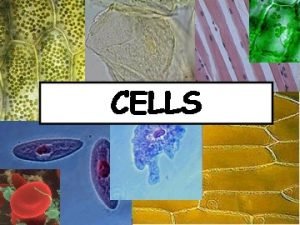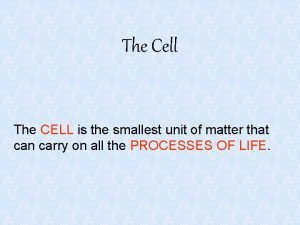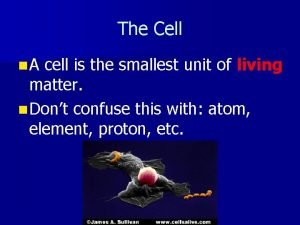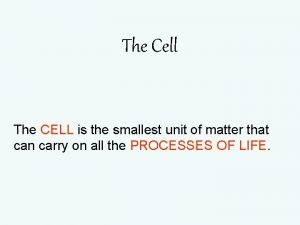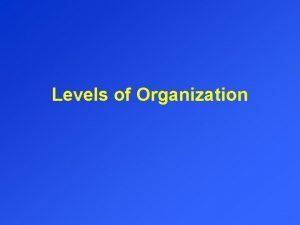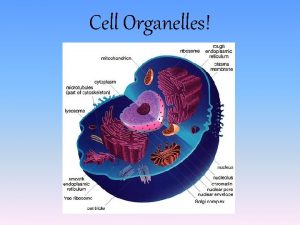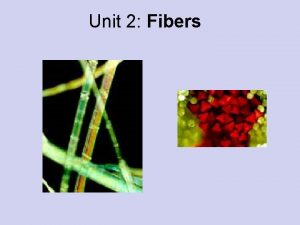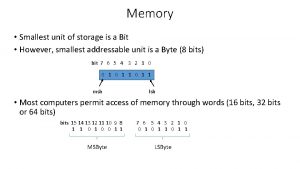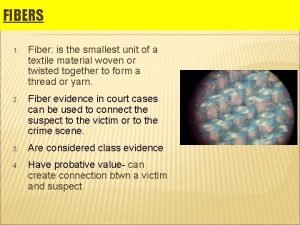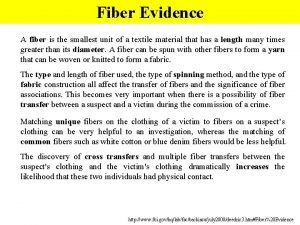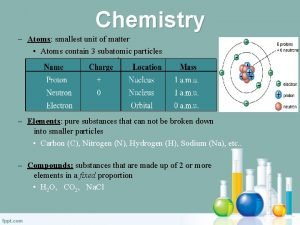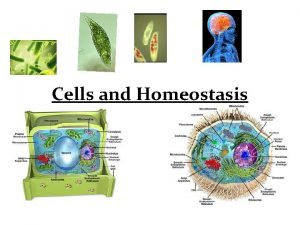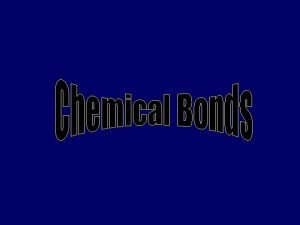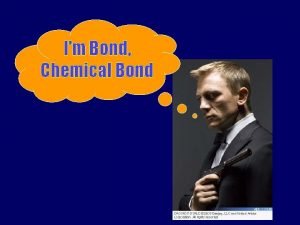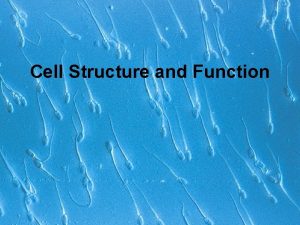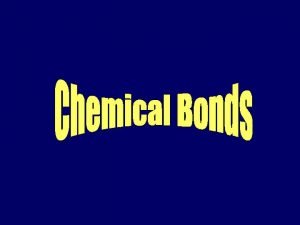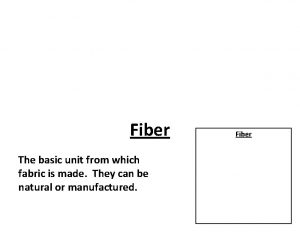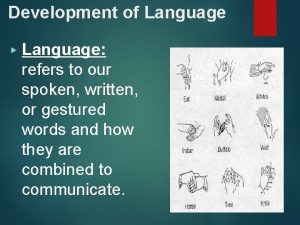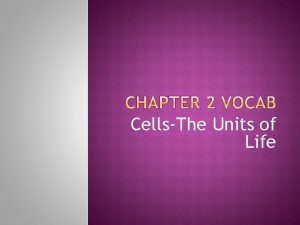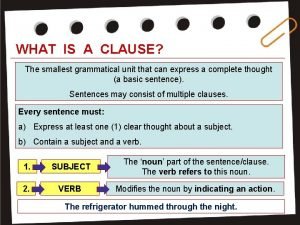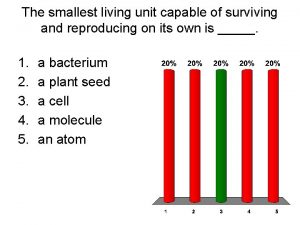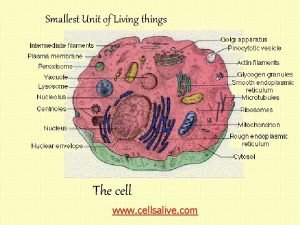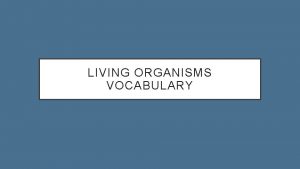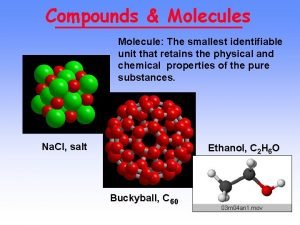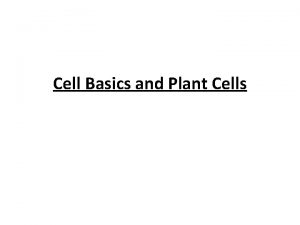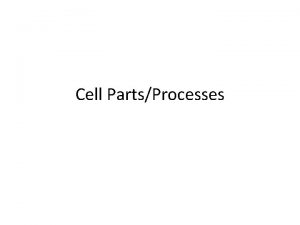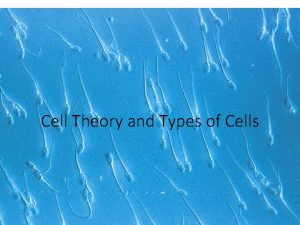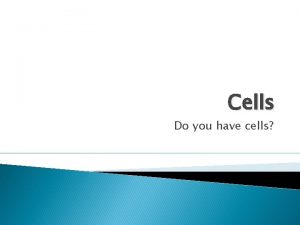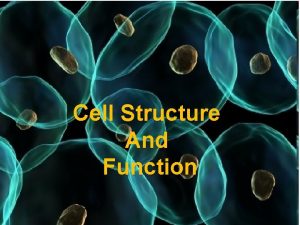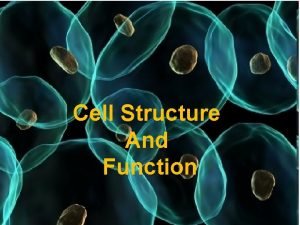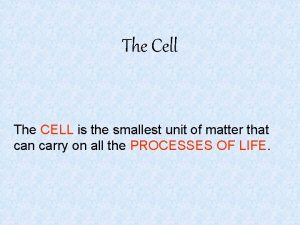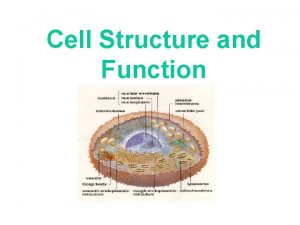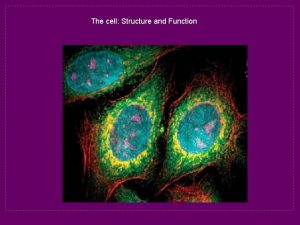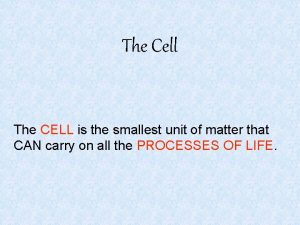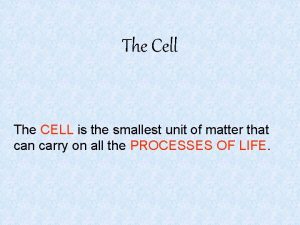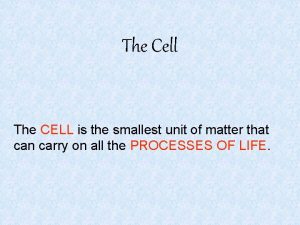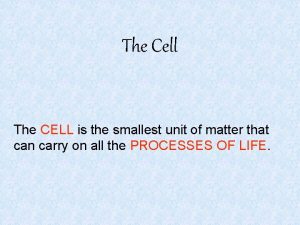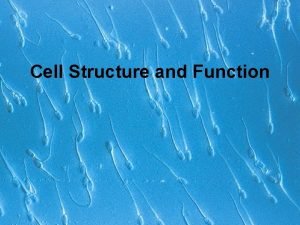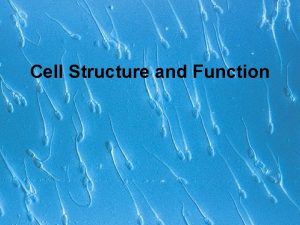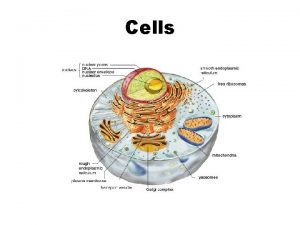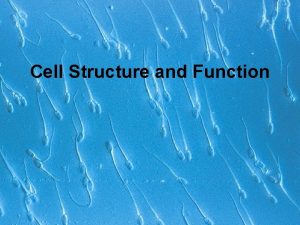Cells Cells Cell is the smallest unit of






























- Slides: 30

Cells

Cells • Cell is the smallest unit of life • All living things are made up of cells • Cells come from other cells What do these three things make up?

What are Cells?

These people are important! • Leeuwenhoek – first to use the ground lens for magnification (glasses, magnifier) • Hooke – saw the first cells under a microscope (cork cells) • Schleiden, Schwann, Virchow – tested and wrote the cell theory.

• http: //ed. ted. com/lessons/the-wacky-historyof-cell-theory#watch

Organelles • Small organ like structures that are found in a cell that perform a specific function for the cell.

Cell structures • Cell membrane - protects and controls what goes in and or out of the cell • Cytoplasm - semi-fluid or jello like fluid that holds all the structures inside the cell • Cytoskeleton – give shape to the cell • Nucleus – “BRAIN” of the cell controls everything that takes place in the cell

Cell Membrane • Cell membrane is a thin layer of lipids and proteins that protects the cell from the outside environment and controls what comes in and out of the cell. • This is the way the cell stays at homeostasis with it’s environment.

Membranes • Semi permeable membranes that only let in certain molecules and keep out others. There are special sized openings that open and close to regulate what goes in and out of the cell. • Membrane gates are the names for the openings and fit special molecules and open and close as needed for the cell.

Transportation of molecules in the cell • Passive transport – uses no energy to move molecules in the cell. Molecules move from a high concentration to a low concentration (dying eggs, making tea) “down hill” • Active transport – uses energy to move larger molecules through the cell. Molecules are moved from a low concentration to a high one. This takes a pump to move the molecules and then needs energy to make the pump move. (dissolving sugar in warm water) “pushing the rock up the mountain”

Transportation of molecules in the cell • Diffusion – random movement of molecules from an area of high concentration to an area of lower concentration (Cool Aide) • Osmosis – moving of water only across a cell membrane.

Transportation of molecules in the cell • Exocytosis – removing of molecules from the cell. These molecules are usually packaged by the Golgi apparatus. Cell waste release or eating and digestion • Endocytosis – pulling in of molecules into the cell ingestion or eating. • Pinocytosis – taking in of small amounts of liquid for the cell. Cell drinking.

What is the membrane made of? a) Phospholipids- lipid made of glycerol, two fatty acids and a phosphate (grout) for the cell. (phospholipid bilayer membrane) b) double layer membrane with an area in between the two backbones. The heads of the phospholipids repel water the tails like water and keep a layer of liquid surrounding the cell for shape and protection.

Let’s look at it now… • https: //www. bing. com/videos/search? q=cell +membrane&&view=detail&mid=E 83 B 6 D 6 D 73 A 0 B 96 ED 7 AAE 83 B 6 D 6 D 73 A 0 B 96 E D 7 AA&&FORM=VRDGAR

Nucleus • Controls the happenings of the cell • Houses the DNA (chromosomes) • Houses the nucleoli (proteins of the cell) • Is surrounded by a membrane of its own to help protect it because it is so important to the cell • The BRAIN of the cell

Nucleus a) Chromosome has all genetic material for the cell (high in protein) b) Nucleolus is where the protein is concentrated in the nucleus. c) nuclear membrane is the membrane that helps to protect the nucleus

Cytoplasm • A semi-fluid substance inside a cell that all organelles float in (Jell-O like material) • Made up of many different molecules • High in sugars and carbohydrates for energy for the cell • Also has the structural support for the cell and may contain some proteins

Cytoskeleton • A network of protein fibers found all over the cell in the cytoplasm that helps give shape and support for the cell

Cell Types • Prokaryotic cells are cells that DO NOT have a nucleus. These cells are the first cells thought to be on the planet. They are basic and do not function well and do not have well defined organelles in them. Example: Bacteria and Viruses

Cell types • Eukaryotic cells are cells that have a true nucleus and have a control center. These cells are well organized for the most part and have well defined organelles that have specific functions. These cells tend to be much more complex. Example: plant and animal cells

ER • Endoplasmic Reticulum is often called ER. This organelle in the cells acts as a road way and processing area. These areas move material in the cell and also make proteins. Smooth ER- will only move material in the cell. Rough ER- makes protein and moves them through out the cell.

Rough ER Must have ribosomes attached to it. Ribosomes- are organelles that are attached to ER or they can be in the cytoplasm on their own and make the long chains of macromolecules called proteins. (protein synthesis)

• http: //www. youtube. com/watch? v=w. Jy. Utbn 0 O 5 Y

Golgi Body or Apparatus • Flat membrane structure that folds over itself that traps material (conveyor belt for trash and debris) • Once the material is trapped it is packaged into small pieces called vesicles that moves this material to the ER or to and from parts of the cell and nucleus • If it is trash, then it is removed from the cell by strong enzymes that break the packages and release the material from the cell.

Lysosomes • These are the strong enzymes that break the vesicles apart and release trash out of the cell • They also break down larger molecules into smaller ones that can be transported through the cell with less energy use. • Work hand with the Golgi Apparatus

Mitochondrion • This is called the power house of the cell. • This changes stored energy into usable energy (potential/kinetic) • It makes the ATP which is the energy that the cell needs to stay alive. • This organelle changes oxygen (O 2) to high energy molecule called Adenosine Triphosphate (ATP)

Animal Cell Movement • Cilia are small hair like structures that are attached to the cell membrane and move in a beating motion to transport the cells from one area to another • Flagella are whip like tails that move a cell, they are attached to the cell membrane as well.

Plant cell • Cell wall is found only in the plant cell and adds extra protection from the elements because plant cells can not move! • The cell wall is made of cellulose (starch) that adds rigid structure to the cell. • This is what makes a cell look square in shape. • The wall also keeps the plant cell from losing water (H 2 O)

Plant cell • Vacuole holds water for the plant cell and is the largest organelle in the cell. It supports the cell in shape because of it’s huge size. • It pumps water to parts of the cell that need it when they request that water be used. • This is what makes a plant look plump or wilted

Plant cell • Chloroplast is an organelle that is only found in the plant cell and gives the plant it’s green color. This organelle houses chlorophyll and this is what changes carbon dioxide (CO 2) into the ATP for the plant cell. • This organelle changes sunlight energy into ATP.
 What is the smallest unit of life
What is the smallest unit of life Cells are the smallest unit of life
Cells are the smallest unit of life Cells are the smallest unit of life
Cells are the smallest unit of life Smallest cells
Smallest cells Smallest cell organelle
Smallest cell organelle What is the smallest part of a plant
What is the smallest part of a plant Smallest organelle in a cell
Smallest organelle in a cell The smallest unit of a textile is called a fiber
The smallest unit of a textile is called a fiber Principle of superposition
Principle of superposition Smallest unit of computer memory
Smallest unit of computer memory Smallest unit of nylon
Smallest unit of nylon Hair is the smallest unit of a textile.
Hair is the smallest unit of a textile. Are atoms the smallest unit of matter
Are atoms the smallest unit of matter Smallest living unit
Smallest living unit Smallest living unit
Smallest living unit What is the smallest unit of matter
What is the smallest unit of matter Smallest addressable unit of memory
Smallest addressable unit of memory Smallest unit of metallic bond
Smallest unit of metallic bond Smallest unit of nylon
Smallest unit of nylon What is the smallest living unit in the body
What is the smallest living unit in the body The smallest living unit is
The smallest living unit is Whats the smallest unit of matter
Whats the smallest unit of matter The basic unit of fabric is
The basic unit of fabric is Language refers to
Language refers to What unit of size are the smallest organisms found on earth
What unit of size are the smallest organisms found on earth Smallest grammatical unit
Smallest grammatical unit Smallest living unit
Smallest living unit Smallest unit of life
Smallest unit of life What is the smallest unit of living organisms
What is the smallest unit of living organisms Economic protest parties definition
Economic protest parties definition What is the smallest identifiable unit of a compound
What is the smallest identifiable unit of a compound
